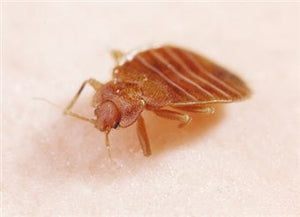Bed Bug Reports Show Heat Treatment Effective
Decreased Power of Pesticides
A 2011 bed bug report by Ohio State University has troubling news about bed bug’s increasing resistance to conventional pesticides. Genetic testing has revealed that bed bugs are increasingly generating high levels of enzymes that allow them to purge pesticides from their bodies. As a result, they are able to withstand pesticide levels a thousand times stronger then those that would have killed infestations just a decade ago. There is also evidence of regional variation among bed bug populations – those in New York City are 250 times more resistant to pesticides then those in Florida. Further research by the Virginia Polytechnic Institute suggests that this isn’t the only method by which bed bugs are increasing their resistance. Their exoskeletons are also becoming thicker, preventing the pesticides from getting inside them in the first place.

Adult Bed Bug
Even banned pesticides like DDT wouldn’t have the same effect on bed bugs today. Their immunity levels remain high, even though the use of DDT was banned in the United States in 1972. Researchers fear this suggests that the changes we’re seeing to bed bugs now will remain part of their genetics; and since bed bugs don’t pass along viruses, funding for research into new preventative pesticides isn’t a priority.
What Does Work?
Luckily for us, heat treatments are still an effective, and cheap, way to kill off bed bugs. A thorough study on localized heat treatment of bed bugs by the Entomology Department at the University of Florida tested what temperatures and controls are needed. All tests were conducted using full room heat treatments, as would be employed by professionals contracted to heat treat dwellings. Their results revealed the following:
- Bed bug survival decreased with longer exposure at temperatures between 41C – 49C (105F – 120F).
- Ten minutes at 45C (113F ) will kill bed bugs.
- Lethal temperatures for bed bugs are below those that would damage most furniture commonly infested.
- Bed bug eggs can also be killed by heat treatment, although their results required temperatures 1C (approximately 2F) higher then adults.
- Even sub-lethal temperatures can prevent bed bug reproduction.
During the study there were two cases in which the bed bugs survived the treatment. Both occurred in rooms with tiled floors, which are much slower to heat then those that are carpeted. The first failure was due to an interruption in the heat treatment cycle, which allowed the bed bugs to survive. In the second case there was insufficient equipment to monitor the heat throughout the room: although lethal temperatures were reached where the thermometer was placed, the more insulated dresser that contained the bed bugs was not fully heated. This was fixed by attempting again with polystyrene sheathing around the treated furniture to act as added insulation, as well as more use of internal temperature probes, better spacing of heaters, and the use of circulation fans. Circulation fans increased heat rapidly, which quickly immobilized bed bugs and shortened treatment time (well below the 16 hours mark used for full room treatments, in some cases less than 6 hrs).
Consumer Options
There are options available for the general public. Bed bug research at Virginia Tech has shown that heat can be used in different ways: for small personal items, they recommend using clothing dryers as well as portable heat treatment devices. While dryers can be faster and reach a higher temperature, portable heating devices are better able to accommodate a large variety of infested items. For larger items and dwellings they recommend the following methods:
- Steam cleaning, especially for large upholstered furniture. This method can be slow and requires expert use by technician if it’s the only treatment being used.
- Heat chambers – either do-it-yourself (requires setting up and purchasing components) or purchased.
- Whole room heating: this must be done by professional, which can be expensive. As well, some buildings can have heat sinks that mean it must be combined with other methods.
Another report on bed bugs by the University of Kentucky has helpful tips for avoiding infestations. Although having a clean house will make it easier to treat and contain bed bug infestations, they are not a cause. Instead, bed bugs are normally transported on infested material. Bed bugs are active during the night, and hide during the day in areas marked by dark spotting/staining, eggs, and shed skin. Look out for rusty or red smears from crushed bugs as a sign of their presence. When travelling, check over hotel bedrooms, especially bed sheets, mattress seams,and around the headboard. Make sure to elevate your suitcase off the floor. Since bedbugs don’t jump and travel like fleas do there is less of a risk when the suitcase is away from possibly infested areas.
Emergency and social workers are another group at risk for exposure to bed bug infestations. When in a potential infested residence avoid placing items such as coats on beds, sofas, or the floor. Attempt whenever possible to sit on hard non-upholstered furniture. If removing a person from the dwelling, remove bed-bug infested shoes/clothing. If you suspect bed bugs have spread to you, your first step should be to put items that can fit in a clothing dryer for 10-20 minutes, such as bedding, clothes, shoes, and backpacks. This can also be done for most clothing that states dry clean only.
Posted by Rose Eckert-Jantzie


